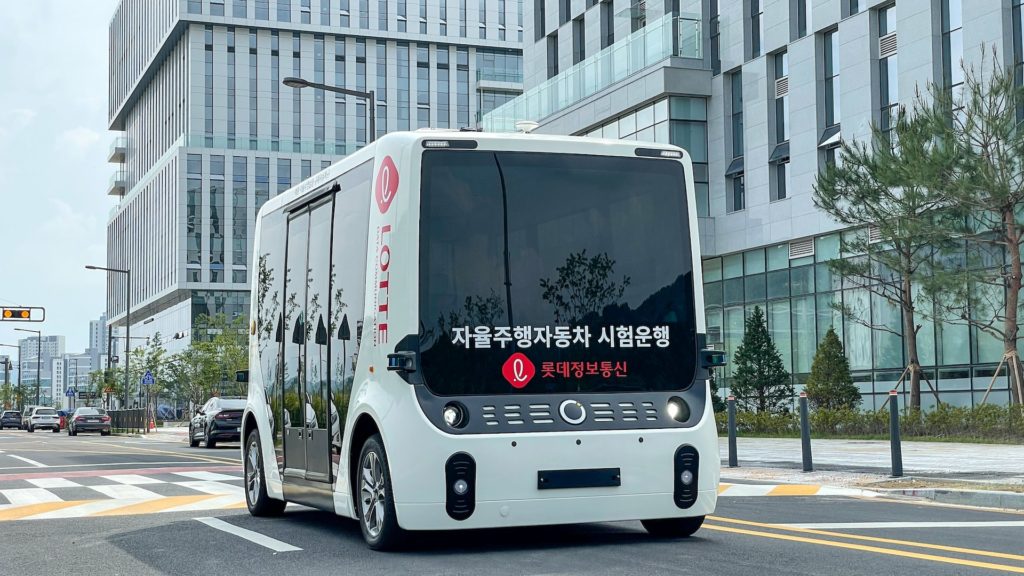Automated Mobility for Road Safety
Automation has the potential to increase the accessibility of mobility.
When we think about automated mobility solutions, we immediately picture self-driving cars taking us to a new and futuristic era of mobility where traffic does not exist, and we can use our time in more productive ways while commuting. But when will this be realistic? How can it make our mobility more sustainable, and how can it help improve our mobility systems today?
REVOLVE talked to Ingrid Skogsmo, Ph.D., Senior Research Leader at the Swedish National Road and Transport Research Institute (VTI) – President at the European Conference of Transport Research Institutes (ECTRI), and an expert in automated and connected mobility, self-driving vehicles, and road safety to try to answer those questions and understand a bit better what autonomous mobility is all about – and what it is not.

What solutions can automated and connected mobility bring to the road transport sector?
‘Automated solutions’ is a very wide expression. It can be a driver’s support system, like adaptive cruise control, an automated system partly (that is not fully) automated; it can be, completely self-driving vehicles without any driver at all like robo-taxis and robo-deliveries. Driver support systems can help drivers perform better. Also, connected solutions can be a part of the traffic management systems, in which case they can help to make transport more fluent and efficient. If it is completely automated, it can obviously be in places where you cannot access it with the driver. It may give new opportunities to work in mines, for example, connected and automated vehicles can thus bring solutions over a very wide spectrum.
Why are these innovations important for more sustainable mobility?
Implemented in a thoughtful way, traffic could be more fluid thanks to automated solutions. It may become more efficient and contribute to less time in congestion and less emissions. But sustainability can also mean safety. If you can help drivers perform safer by using connected and automated systems to detect things in a clearer way, for example, if you detect pedestrians earlier, predict their intentions and then transfer that back to the vehicle so it automatically brakes, that of course can improve safety. It can improve the performance of the drivers, but also if you think about sustainability, being fairer, giving access to groups that, maybe, were not able to move independently before, like people with reduced capabilities, vision problems, or mobility problems, maybe this can allow you to have a much more independent type of mobility.
Automated solutions can also help improve the working conditions for drivers or to create better jobs in different locations that can be hard to work in, like mines or very remote areas.
Which users’ needs does automated mobility address?
If we do not need a driver, then part of the operation or the service cost would be reduced. This could help create better business cases for delivering things to rural or more remote areas with automated vehicles going there. Today it may be too expensive to send deliveries to people living in these areas. So, if we can do that without the driver, automated solutions could serve areas that are not accessed today. Of course, this assumes vehicles that are able to cope with the traffic environment in remote and rural areas, which is not necessarily the case yet.
On another note, automated solutions can also help improve the working conditions for drivers or to create better jobs in different locations that can be hard to work in, like mines or very remote areas.

What are the main safety concerns and how can they be tackled?
We need to be patient. Five years ago, everyone said that technology was ready. But experience has proven that it was not as easy as we thought. We are learning a lot, and we must test the technologies, but of course in a controlled manner.
One of the challenges is how you validate the performance of an automated system. It is not just how many miles you have driven without running into something, it is much more. You must have a broader perspective, so it is all about ‘testing, testing, testing,’ but doing it in a controlled way and taking step-by-step approaches in introducing the systems. In most European countries you need to have a permit for automated driving on public roads. When applying for a permit you must prove the safety case – you must show that you will not cause any safety problems and show how you will tackle different challenges, like how the automated vehicle will react if a pedestrian enters in front of the vehicle. Take shuttles, for example.
Today the focus is on not running into anything and the brakes may be designed to ensure that if the shuttle travels at say 40 km/h you do not hit a pedestrian. For a shuttle traveling at a much lower speed, for example, 15 km/h, the brakes really kick in quite aggressively if it detects a pedestrian in front of the vehicle. At this quite low speed, this may be uncomfortable and dangerous for the passengers in the shuttle. There is an unbalance between the interior and exterior safety that needs to be addressed.
We, the public and the users, must understand the limitations of what automotive vehicles can and cannot do. Also, of course, when designing these systems, that should be done so they are “foolproof” – it should not be possible to misuse them. It is critical to be humble and not oversell systems while they are still being developed.
We, the public and users, must understand the limitations of what automotive vehicles can and cannot do.
Why is it important to consider the stakeholders’ involvement and perspective? Is there enough communication and collaboration with the manufacturers implementing the solutions?
Communication between different stakeholders and bringing in different points of view can always be improved and there are several actions aiming to do so. In Europe, we have the CCAM Partnership, where CCAM stands for Connected, Cooperative, and Automated Mobility. The partnership involves about 200 different stakeholders: manufacturers, researchers, member states, cities, regions, operators, suppliers, and the telecom industry. Even if some user groups are also represented, the interaction with them can be further improved.
Within this partnership, we have seven different areas that we are addressing. Vehicles are, of course, one topic being discussed, but there is also one team working on societal aspects and people’s needs.
Now, I think everybody understands that automated mobility will only make an impact if it is used, understood, and appreciated, and to achieve that you cannot just say, “look, here is our new technology, please like our new technology.”
The technology has to serve a purpose and I think this is understood, there is a lot of concern about thinking about people, bringing in users, of what people do, where CCAM solutions can be of use, what can make life better, funnier, easier, cheaper. I think this recognition is increasing and we have to work on the mechanisms and projects that make this happen.
I think everybody understands that automated mobility will only make an impact if it is used, understood, and appreciated.
What is the test phase status? When do you expect this to become a commercial reality or commonplace on the roads?
There are systems out there today. Adaptive cruise control is something along these lines, emergency breaking in new vehicles too. I think you will see more autonomous solutions in closed areas, in industrial areas there are already tests taking place, and there are driverless trucks transporting things. It will take a long time until you have no steering wheels in most vehicles that can take us everywhere; this is a long term. Testing and validation have to go on and will take quite some time.
I used to work on the policy side, and the task was to ‘accelerate the deployment of automated mobility.’ I have also been involved in implementing a shuttle project in Sweden, these square-type shuttles for six to eight people, with a safety driver, and I felt that we ran into new surprises every day – like the grass had grown and the sensors did not accept that. It will take some time until we have those robo-cars that pick you up and drive you to any place you want. I do not think I will ever live to see that being widespread.

What policy barriers do these solutions find, especially in the EU context? Is there any country taking the lead or can you give some examples?
In the European perspective, there are different approaches to what you are allowed on the road and how you get a permit for operating on the public roads. The procedures are different but there are efforts to harmonize more how we do this.
It is hard to say if somebody is taking the lead or not, it depends on where you look, but I think we need some common ideas of how you validate things, what is valid, and what is required to release automated vehicles for wider use in public areas.
There are standards being set up for human-machine interaction for vehicles. Single components and elements of automation are being standardized and that goes throughout Europe. There is a lot being done and that is good because if you sum up all these experiences, we probably can get some good ideas on what best practice is. The beauty of Europe is this multitude that we can learn from, and I think that is the task we must take on.
One barrier to implementation is the difficulty of knowing exactly what is safe enough, another one is that you lack common standards. Regulation, permissions, how you deal with cross-border communication, you have to find business cases, how to fund these, and with what infrastructure. Also, a further barrier is to agree on who is responsible for what, and how to deal with responsibility and liability. If we can take a European approach, and leverage Europe’s diversity in handling the issues we have discussed here, we will have a good chance to bring CCAM on the road where it makes sense, is useful and appreciated, and thereby can contribute to higher accessibility.